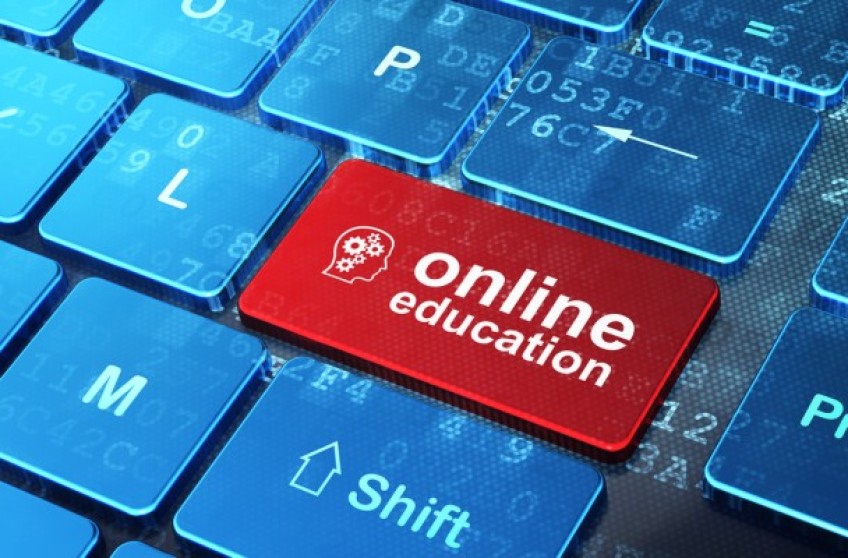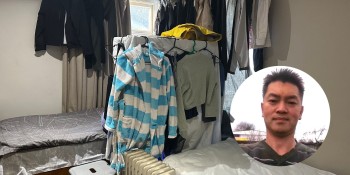Too cool for school

Queenstown writer and teacher Poppie Johnson explores the world of online computer learning. Is it the perfect escape from all of the distractions and problems of traditional schooling, or will it produce students who lack vital social and community skills?
Two years ago, then Education Minister Hekia Parata announced the broadest reforms to take place in New Zealand education legislation for 27 years. The introduction of ‘Communities of Online Learning’ (or the perhaps too-intentionally clever acronym of ‘COOL’) outlined a programme where school-aged students could complete some, or all, of their learning online.
Let’s be clear, we’re not talking about a governmental mandate for the future of all students’ education. It’s an option. That’s an important distinction.

Could online learning ever make teachers redundant?
The response was immediate and forceful. Rather than focussing on the potential positives, negative news articles immediately propagated across the national media. Reports abounded, describing outraged teachers, irate parents and the subversive fear that students would lose the ability to socialise, will only interact with devices and will lose valuable interpersonal skills that only brick and mortar schools are be able to provide.
A change of government, a year later and the sky has not yet fallen. No new online schools have yet emerged. The press has been curiously silent with no reports on the current status of these policies coming into effect.
So what happened? The legislation was passed in May of last year and due to be effective from the end of 2018. In response to a query, Anne Kidd of the Ministry of education responded:
“The provisions relating to Communities of Online Learning have a delayed commencement and are currently set to come into effect by 31 December 2019. However, earlier this year the Minister consulted on a proposal to repeal the provisions relating to COOLs and to consider the approach to online learning within a broader strategic discussion with the education sector.”
Online learning is clearly going to be a part of the future of education, yet it looks as though this government, and Education Minister Chris Hopkins, are going back to the drawing board.
As he put it in March of this year, just prior to consultation closing; “One of the key things we are looking to do is get rid of the deeply unpopular provision to provide for the establishment of communities of online learning – the so-called COOL.” The Minister went on to twist the knife in National’s back a little; ‘…the previous Government ploughed ahead with the legislation for online providers despite experts and education professionals raising a number of concerns.’
So, are those concerns enough to repeal and delay the legislation? Is this delay costing our students opportunities? Are there any benefits to allowing online schools to proliferate or is the current model of integrated technology and online learning sufficient?
Our current education system is based on a logical response to the need brought about by the Industrial Revolution and the social structures in place in schools represent that. Technology is well integrated and modern pedagogies (how we teach) are in use. Yet just as the concept of having to physically be at work for a rigid 40-hour week is changing, so too should the concept of school. Currently it is inflexible: the number of half-days that a school must be ‘open for instruction’ are mandated by the Ministry and with very few exceptions schools run for the same six hours a day, Monday to Friday.

The social side of school can be a plus in terms of learning interpersonal skills, but it can also produce bullying and distraction.
Research supports positive aspects of online learning. A University of Canterbury case study references research stating that the benefits of online learning include:
‘…enhancing student motivation, expanding educational access, providing high quality learning opportunities and improving student outcomes and skills are among the benefits of online education. In addition, online modes for education can play an important role in preparing students for the 21st century where learning is recognised as a process that results in generating new knowledge, a motive power to do new things.’
As with any rapidly changing and developing area, there are challenges too. Yet the benefits and omnipresent nature of online learning suggests that figuring out the most effective way to utilise technology will be the best use of time.

The NZ Correspondence school used to rely on printed materials and booklets before computers and the internet arrived on the scene.
When I was ten, I spent two years working through The Correspondence School, as it was then known. My family was travelling frequently and distance learning was the only way to obtain consistency. No online learning for me, booklets for each subject were mailed to and fro on a weekly basis and when possible I would attend the local school for a day or meet up with other correspondence kids. Slightly sporadic, but a good education.
Te Aho o Te Kura Pounamu, as The Correspondence School is now known, is the only licensed distance learning school education provider in New Zealand. They cater to over 23,000 students from a range of different backgrounds: those living remotely, those medically unfit to attend school, young parents, elite athletes, those excluded from regular schools and others that cannot attend regular school. Unlike most schools, Te Kura welcomes eligible part-time students and many enrol for one or two courses only. There’s a great flexibility in that system. They do a great job, but they are doing it for an enormous and tremendously diverse group of students.
Access to Te Kura is restricted – eligibility is determined by whether or not individuals meet the enrolment criteria determined by the Ministry of Education. So students cannot just choose to enrol for courses, and must go through a ‘referral gateway’ to determine eligibility. The concept of COOLs is to make online learning a real choice, open to anyone, from anywhere.
Te Kura was slated to become the first COOL under the new legislation. Others, both private and state-funded, could then apply to be registered as COOLs and provide learning through online platforms to both their own existing, or entirely new groups of students.
So what could some of the positives of this approach be? More providers would allow for more specialisation, and hopefully, better outcomes for students. The possibilities present themselves immediately: for example, an online school for elite athletes that integrates specific sports psychology and training modules to ensure holistic development or an online school that provides a mentor and individual counselling for students excluded from regular schools. Beyond those who require full-time distance learning, opening up the industry will allow a broader range of courses to be offered to students on a part-time basis. That’s a golden opportunity for the hundreds of thousands of domestic students who attend a smaller school outside of the main centres.

Could group remote learning be a compromise - or just another distraction?
This type of diversification offers opportunities not only to students, but to teachers. Online teaching could be a way to keep more teachers in the profession and to attract more diverse individuals. It is well suited to part-time work. In the original legislation, two of the stated aims for COOLs were ‘to increase opportunities for students to access teaching and subject matter expertise…’ and to ‘inject expertise and innovation into the state system by enabling private providers to deliver some or all of a student’s education.’ Those aims are not fully met by current integration of Virtual Learning Networks. Hopefully when the Education Minister repeals and reviews the legislation he will be open to maintaining the positive outcomes originally intended.
One of the key arguments against online learning is that if it were available to everyone teens may opt out of traditional high school and fail to learn social skills and develop relationships.
There are important social opportunities at school, no doubt, yet for every student who appears happy and well-adjusted there is the story of the hidden faces. In fact, 94% of NZ teachers have admitted that bullying occurs at their school. These are not solitary incidents - around 45% of NZ teachers and staff said verbal & social/relational bullying was brought to their attention once a week, while 25% heard of physical bullying once a week. There are benefits to the interpersonal skill development and socialisation that school offers but there are also dangers. Online learning offers an opportunity - we will need to be careful to implement it wisely, but if done well it could facilitate an equality of education and breadth of access that can offer individualised programmes to more students.
I agree that relationships are the cornerstone of a good education. I just don’t believe that there is only one way to have a relationship, or that online learning equates to a systemic destruction of interpersonal learning. Its disingenuous to ignore a crucial factor that will influence our children’s working lives: they will need to learn to interact globally with people online, not just in person. As companies expand across national borders and the workforce becomes more connected, being at ease in an online environment will become an increasingly important skill. Online learning prepares students for that future reality.
So, if we know what the potential pitfalls are, how about a look at the other side of the coin: picture an education system that has inbuilt flexibility and doesn’t rely solely on teacher input for differentiation (teaching to different levels to match students’ ability). This utopian vision of an education system would not only allow students to access their educational potential but would allow them to be placed by ability level into classes and be regularly monitored according to progress as well as achievement. They could interact with specialists in different fields of expertise and not have to be confined by geographical barriers that otherwise prevent access to specialist subjects. Athletes could easily make time for academies of sport and extended practices to ensure an all-round education that doesn’t have to compromise.
Sounds good. Just impractical, right?

Stanford Online School - one of the fastest growing in the US.
Stanford Online High School is one of the fastest growing schools in the United States and caters to students from more than 45 different states and 27 countries globally. The average class sizes are 15, students meet bi-weekly with their instructors and learn through a combination of synchronous and asynchronous study. 68% of teachers have PhD’s in their specialist subjects and the school draws heavily on its physical proximity to Stanford University in order to disseminate that scholastic skill. Students have the flexibility to enrol full-time, part-time or even in just a single module. There’s even a school mascot - his name is Pixel.
That’s just one example you say, it’s not reflective of what this proposal will look like.
Why not?
If the relentless march of technology has taught us anything it is that developments come swiftly and ultimately improve our lives. The success of online programmes such as Khan Academy and Coursera has seen education become available globally. The Massive Open Online Courses (MOOC) movement is providing internationally recognised content to anyone with a laptop and an internet connection. I can sit in my living room and attend a course from Harvard or Yale - for free. If we are already integrating technology into the classroom through measures such as Bring Your Own Device (BYOD) to allow access to such programmes then surely the next step is to create and deliver content that is grounded in local contexts and relevant to the New Zealand Curriculum?
The technology on offer is nothing less than spectacular. One example is Labster - an online and fully interactive laboratory simulation. Their imaging is top-notch, fully 3D and gamified to engage learning. It’s the sort of thing that gets students incredibly excited and highlights how far technology has come in a short time. More than 150 institutions worldwide use their technology - both online high schools and some of the top universities in the world. It’s like having a lab on your laptop, accessible 24/7 and with the ability to do experiments over and over again.
That sort of development highlights how Queenstown is uniquely placed to benefit from online learning. Our start-up ecosystem is growing rapidly and the education sector is a clear natural partner. Online schools require content management systems, seamless integration of technology and responsive and agile media solutions that not only gamify learning but make it accessible. There are existing programmes out there, but many are very American in design and output. Home grown always suits us better. Not only that, there’s a worldwide market for exporting new and exciting developments.
At the risk of delving into Ready Player One territory, virtual reality is the next big thing in education. There’s no way it can’t be. The concept of being able to physically experience a place or sensation as you’re learning about it is exciting. Fact retention is old news, Google put paid to that method of learning. We don’t need to know things anymore, we need to know how to react and have enough baseline knowledge to determine future pathways and extrapolate concepts.
Virtual reality development allows for some pretty neat learning to occur. Think field trips, immersive anatomy lessons, showing art or complex machine systems in 3D to be fully explored. The possibilities are infinite. The technology also allows students to learn by doing, rather than by just seeing.

Virtual Reality Learning - inevitable but harmful?
Google Expeditions is already making big strides in the field trip arena. They have over 800 virtual-reality (VR) and 100 augmented-reality (AR) tours. There is a little bit of equipment required but the trips on offer are impressive - outer space, Machu Picchu, The Great Wall of China, not to mention many different museums and other historical locations.
This sort of technology offers an outlet for software, hardware and other highly skilled development. That’s exactly the type of start-up that would thrive in Queenstown. Not only that but it highlights the positive aspects of online learning - more opportunity, not less. A survey conducted in February by a venture capitalist database, CB Insights, looked into what contributes to the failure of startups. The results were clear. Post-mortem examination of over a hundred new businesses showed that 42% failed because there was ‘no market need’ for their product or service. Why is that relevant? Well, there’s a clear market need for NZ-based education technology and Startup Queenstown-Lakes has set itself the target of working towards 100 new sustainable knowledge industry businesses that can employ over 500 people.
Startups provide a natural link to existing providers. Many overseas online high schools are partnered with universities, providing them with an infrastructure, highly qualified staff and a pathway for students to continue. There’s also remote campuses. Just because a school delivers content online does not mean that it cannot have a physical presence that students can visit, or attend if they live in the vicinity.
Auckland University has already developed an online learning programme to support students and teachers in NCEA Levels 1-3 STEM (Science, Technology, Engineering, Mathematics) subjects in the far north. I would love to see the University of Canterbury or University of Otago partnering with organisations such as the Centre for Space Science Technology or Antarctica New Zealand to offer NCEA-accredited online courses for high school students.
The online high school model offers choice on a scale that cannot be emulated by a standard school system. It’s the way of the future, and the path has already been trodden overseas with significant successes. So to those detractors of the proposal, I have the following challenge: how can we look at this as an opportunity to offer flexibility and choice rather than as the death knell of teacher relationships?
Change always brings about an outraged reaction from those who fear loss; it is easier to find holes in something than it is to look for the gateways that those holes provide to opportunity. Change implies that the status quo will not remain. Change means that the landscape is irrevocably altered and that we have to find the courage to create a world that will look different to the one we grew up in. We are trying to teach our children to be adaptable, to learn transferable skills for the average of seven careers that they will experience in their working lives. Surely this adaptability and resilience is a skill that we should model and demonstrate when faced with change?
 Poppie Johnson is a writer and experienced high school English teacher, based in Queenstown. She grew up between Aoraki-Mount Cook and Christchurch, and has worked as a chef, ski patroller and youth work manager, prior to her career in education. Poppie is currently completing the final year of her Masters in Creative Writing through the University of Edinburgh.
Poppie Johnson is a writer and experienced high school English teacher, based in Queenstown. She grew up between Aoraki-Mount Cook and Christchurch, and has worked as a chef, ski patroller and youth work manager, prior to her career in education. Poppie is currently completing the final year of her Masters in Creative Writing through the University of Edinburgh.
Read: Poppie receives a letter from her baby son - 30 years in the future.
Read: Why do boys struggle at school?


























